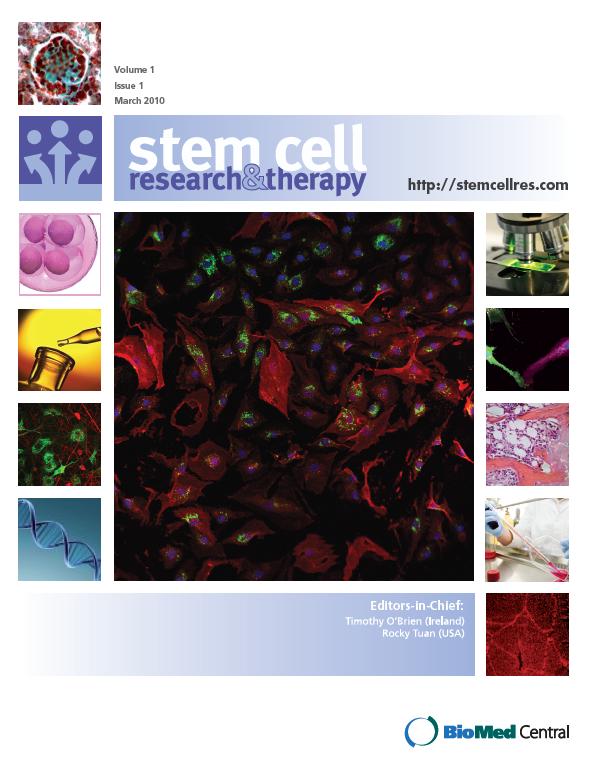Clusterin-carrying extracellular vesicles derived from human umbilical cord mesenchymal stem cells restore the ovarian function of premature ovarian failure mice through activating the PI3K/AKT pathway
IF 7.1
2区 医学
Q1 CELL & TISSUE ENGINEERING
引用次数: 0
Abstract
Emerging evidence has highlighted the therapeutic potential of human umbilical cord mesenchymal stem cells (UC-MSCs) in chemotherapy-induced premature ovarian failure (POF). This study was designed to investigate the appropriate timing and molecular mechanism of UC-MSCs treatment for chemotherapy-induced POF. Ovarian structure and function of mice were assessed every 3 days after injections with cyclophosphamide (CTX) and busulfan (BUS). UC-MSCs and UC-MSCs-derived extracellular vesicles (EVs) were infused into mice via the tail vein, respectively. Ovarian function was analyzed by follicle counts, the serum levels of hormones and ovarian morphology. The apoptosis and proliferation of ovarian granulosa cells were analyzed in vitro and in vivo. Label-free quantitative proteomics was used to detect the differentially expressed proteins in UC-MSC-derived EVs. After CTX/BUS injection, we observed that the ovarian function of POF mice was significantly deteriorated on day 9 after CTX/BUS infusion. TUNEL assay indicated that the number of apoptotic cells in the ovaries of POF mice was significantly higher than that in normal mice on day 3 after CTX/BUS injection. Transplantation of UC-MSCs on day 6 after CTX/BUS injection significantly improved ovarian function, enhanced proliferation and inhibited apoptosis of ovarian granulosa cells, whereas the therapeutic effect of UC-MSCs transplantation decreased on day 9, or day 12 after CTX/BUS injection. Moreover, EVs derived from UC-MSCs exerted similar therapeutic effects on POF. UC-MSCs-derived EVs could activate the PI3K/AKT signaling pathway and reduce ovarian granulosa cell apoptosis. Quantitative proteomics analysis revealed that clusterin (CLU) was highly expressed in the EVs of UC-MSCs. The supplementation of CLU proteins prevented ovarian granulosa cells from chemotherapy-induced apoptosis. Further mechanistic analysis showed that CLU-knockdown blocked the PI3K/AKT signaling and reversed the protective effects of UC-MSCs-derived EVs. Administration of UC-MSCs and UC-MSCs-derived EVs on day 6 of CTX/BUS injection could effectively improve the ovarian function of POF mice. UC-MSCs-derived EVs carrying CLU promoted proliferation and inhibited apoptosis of ovarian granulosa cells through activating the PI3K/AKT pathway. This study identifies a previously unrecognized molecular mechanism of UC-MSCs-mediated protective effects on POF, which pave the way for the use of cell-free therapeutic approach for POF.通过激活PI3K/AKT通路恢复卵巢早衰小鼠的卵巢功能
越来越多的证据表明,人脐带间充质干细胞(UC-MSCs)对化疗引起的卵巢早衰(POF)具有治疗潜力。本研究旨在探讨UC-间充质干细胞治疗化疗引起的卵巢早衰的适当时机和分子机制。小鼠注射环磷酰胺(CTX)和丁胺(BUSulfan)后,每3天对卵巢结构和功能进行一次评估。UC-MSCs 和 UC-MSCs 衍生的细胞外囊泡 (EVs) 分别经尾静脉注入小鼠体内。通过卵泡计数、血清激素水平和卵巢形态分析卵巢功能。对卵巢颗粒细胞的凋亡和增殖进行了体外和体内分析。无标记定量蛋白质组学用于检测 UC-MSC 衍生 EVs 中的差异表达蛋白。注射CTX/BUS后,我们观察到POF小鼠的卵巢功能在注射CTX/BUS后第9天显著恶化。TUNEL检测表明,注射CTX/BUS后第3天,POF小鼠卵巢中凋亡细胞的数量明显高于正常小鼠。在注射CTX/BUS后第6天移植UC-MSCs能明显改善卵巢功能,促进卵巢颗粒细胞增殖并抑制其凋亡,而在注射CTX/BUS后第9天或第12天移植UC-MSCs的治疗效果则有所下降。此外,从 UC-MSCs 提取的 EVs 对 POF 也有类似的治疗效果。UC-间充质干细胞衍生的EVs可激活PI3K/AKT信号通路,减少卵巢颗粒细胞凋亡。定量蛋白质组学分析表明,UC-间充质干细胞的EVs中高表达集簇素(CLU)。补充CLU蛋白可防止卵巢颗粒细胞在化疗诱导下凋亡。进一步的机理分析表明,剔除CLU会阻断PI3K/AKT信号传导,并逆转UC-MSCs衍生EVs的保护作用。在注射CTX/BUS的第6天给予UC-MSCs和UC-MSCs衍生EVs能有效改善POF小鼠的卵巢功能。携带CLU的UC-MSCs衍生EVs可通过激活PI3K/AKT通路促进卵巢颗粒细胞增殖并抑制其凋亡。这项研究发现了一种之前尚未认识到的UC-间充质干细胞介导的POF保护作用的分子机制,为使用无细胞疗法治疗POF铺平了道路。
本文章由计算机程序翻译,如有差异,请以英文原文为准。
求助全文
约1分钟内获得全文
求助全文
来源期刊

Stem Cell Research & Therapy
CELL BIOLOGY-MEDICINE, RESEARCH & EXPERIMENTAL
CiteScore
13.20
自引率
8.00%
发文量
525
审稿时长
1 months
期刊介绍:
Stem Cell Research & Therapy serves as a leading platform for translational research in stem cell therapies. This international, peer-reviewed journal publishes high-quality open-access research articles, with a focus on basic, translational, and clinical research in stem cell therapeutics and regenerative therapies. Coverage includes animal models and clinical trials. Additionally, the journal offers reviews, viewpoints, commentaries, and reports.
 求助内容:
求助内容: 应助结果提醒方式:
应助结果提醒方式:


